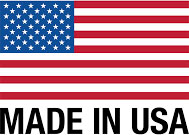Kitchen Cabinet Trends Through the Decades
Posted by Melissa Hollobaugh on Mar 18th 2024
Over the years, cabinet door trends and kitchen styles have drastically changed with the times. The styles, materials, and colors have transformed with each decade to complement the social and economic trends. Whether it was for functionality, budget, or style, each one of these trends dramatically changed the look and feel of one of the most important rooms in your home.
In this article, we'll take a closer look at the cabinet door trends and kitchen styles of the past and discuss their evolution.
1930s and 1940s Kitchen Cabinet Trends

Source: Joan Vanderschut / Courtesy of BHG
Before the 1930s, electric fridges were expensive, and most family homes did not have one. With technology advancements, fridges became a household staple in the early 1930s, and so did built-in cabinets. Kitchen sinks were also starting to be built into the cabinets.
Kitchens in the 1930s and 1940s played with bold colors and patterns. They had wallpaper, decorative mosaics, and checkerboard flooring. Most kitchen cabinets were simple and functional. They were painted in bold colors like black, red, or green. They also had metal cabinet doors with metal cabinet pull or classic cup cabinet pulls. Metal was considered a more durable and affordable material than traditional wood.
1940s kitchen cabinets were almost always metal or steel cabinets. Laminate countertops also became the new norm for the American kitchen, but the bright and bold primary colors were still popular.
1950s Kitchen Cabinet Trends

Source: hardcastletowers / Instagram
In the mid-century, the traditional American kitchen was no longer bright green, red, or yellow. Most kitchens had soft, pastel color palettes and candy-colored cabinets. Light blue, pink, and yellow were the most popular color choices. The floors were almost always traditional vinyl checkerboard, and it wasn't uncommon for a house to have a pale pink or turquoise fridge. 1950s kitchen cabinets and cabinet doors were now almost always metal. Kitchens in the 1950s also almost always had shiny metal knobs and pulls.
1960s Kitchen Cabinet Trends

Source: The Spruce
By the 1960s, wood cabinets had become more affordable. Steel and metal cabinets were no longer the norm and quickly became obsolete. During this time period, woods with knots, streaks, and distinct wood patterns were the most popular choice for kitchen styles. 1960s kitchen cabinets were bold and highlighted the natural beauty of the warm wood tones.
The most common type of wood used for 1960s kitchen cabinets was birch and knotty pine. Both wood types are still used for modern kitchen cabinet trends to this day.
Homes still had bright-colored or pastel fridges and appliances, and dishwashers became the new standard. However, most kitchens are stuck with warm yellow or brown color palettes.
1970s Kitchen Cabinet Trends

Source: Interiors for Today
In the 1970s, Americans waved goodbye to the bright pastels of the earlier decades and started to opt for warm natural tones and natural wood features. Dark wood cabinet doors became the most popular choice for kitchen cabinet doors. 1970s kitchen cabinets are commonly made out of oak or oak laminate.
The dark wood cabinets were paired with light greens, gold yellows, burnt orange, and rich browns. It wasn't uncommon to see countertops made entirely of tile or a bright color laminate. Knotty pine was also a top choice for 1970s kitchens, and the rich tones of the natural wood of the cabinets were the focal point, creating a rustic or country vibe.
1990s Kitchen Cabinet Trends

By the 90s, bright, pastel, and bold colors were no longer a fan favorite. Laminate, wood, and tile countertops dominated 1990s kitchens. Most family homes had all-white or black appliances, and people were switching to lighter-colored wood types for their cabinets. Traditional cabinet door styles with raised or recessed centers were popularized. Many 1990s cabinet doors also featured ornate details and were commonly made of oak or birch.
2000s Kitchen Cabinet Trends

In the early 2000s, granite was the next big thing every household needed in their home. This material was seen as a luxurious, natural stone countertop material. During this time period, all-white, modern 2000s kitchens started to grow in popularity. We saw more slab cabinet doors and cabinets that lacked ornate details.
Homeowners were opting for wood types that had a more subtle grain pattern and didn't have as many knots or streaks. 2000s cabinet doors are still popular for many kitchen styles in the 2020s.
2020 and Beyond
So, what’s the next big kitchen cabinet door trend? Recently, we’ve seen many homeowners step away from simple modern kitchen designs. People are starting to play with more color and texture, letting their personalities shine through the kitchen cabinet door trends they choose to showcase their personalities and aesthetic choices. They are finding a balance between simple and sleek and creative and lively. The same playful pastels used in 1950s kitchens are being used in a more modern way.
Upgrade Your Kitchen Cabinet Doors With CabinetDoors.com
Trends come and go every decade, but the cabinet door trends you invest in may last for 30 or more years. When exploring different styles and materials available online, you want to pick a look that complements your aesthetic and will maintain its look and appearance for years to come.
At CabinetDoors.com, we have a variety of styles and wood species to choose from. Whether you like the classic look of shaker cabinet doors or want a traditional 90s style like our Adobe cabinet doors. We have everything you need to elevate the appearance of your kitchen or bathroom.
Explore our selection of cabinet doors today to get started.



